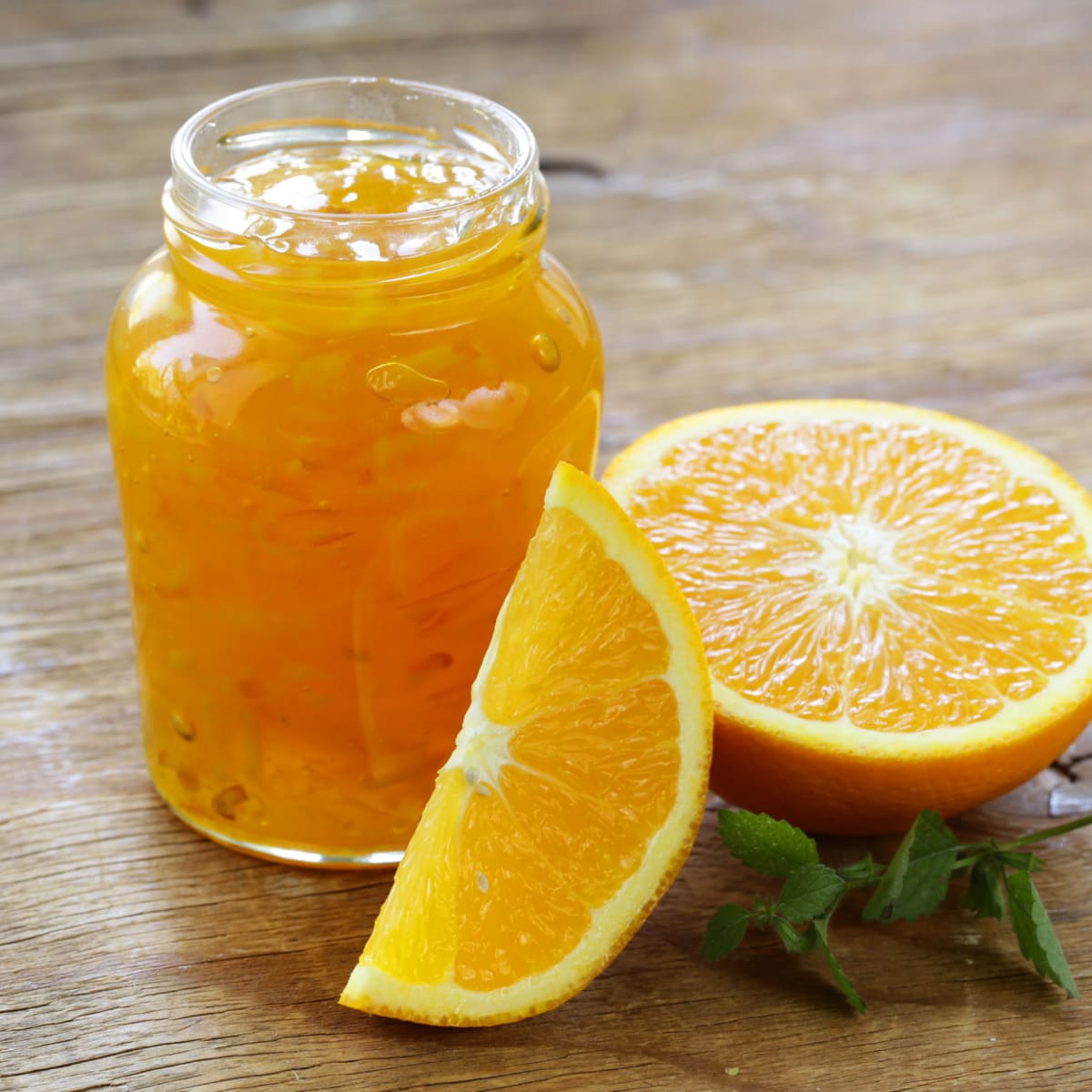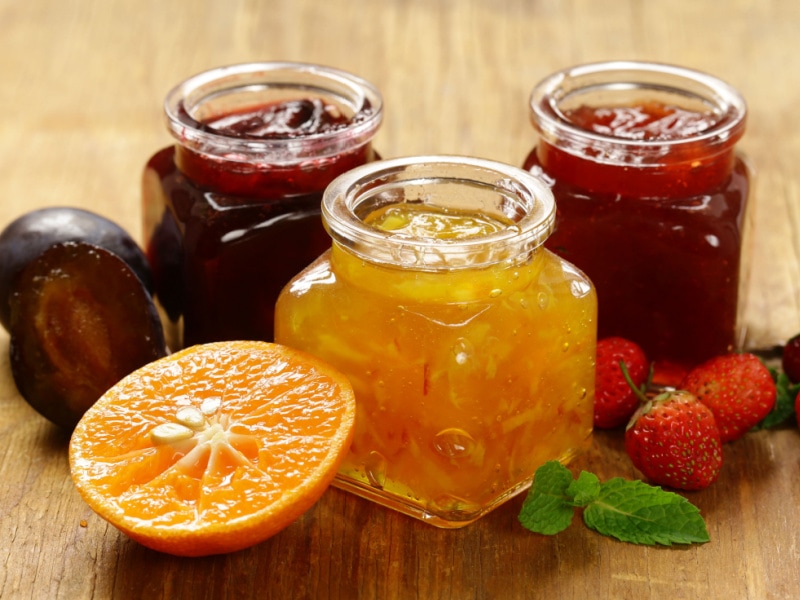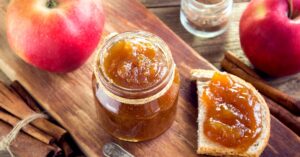Paddington Bear made marmalade mainstream. But what is marmalade? Is it the same as jam or jelly?
I am here to dispel any confusion and provide you with all the delicious details. Plus, I am including my favorite marmalade recipe.

This citrus breakfast staple is tangy and sweet. But it has just enough bite to get you up and moving in the morning.
It is fabulous on toast or scones. But it is not out of place in a salad dressing or meat glaze.
So, grab your toast and settle in. Come explore the fascinating world of marmalade with me!
What Is Marmalade?
Marmalade is a delicious preserve made from citrus fruits and sugar.
Classic marmalade uses oranges or lemons in its creation. Although, you can use other citrus fruits like grapefruit, too.
It also has several variations, including chunky, smooth, and infused.
You make marmalade with simple ingredients in an easy cooking process.
You only need citrus fruits, water for boiling, and sugar. And you cook it all down together. More on this later.
Marmalade is the perfect choice if you want a sweet and tart treat. Enjoy it as a spread on toast, crackers, or even pancakes.
You can also use marmalade to flavor dishes like stews and sauces. Yum!

What Does Marmalade Taste Like?
Marmalade has a unique flavor that is hard to compare with other fruit jams.
It is tart, sweet, and bitter all at once. And, of course, this flavorful spread has a delicious citrus taste.
Marmalade smells slightly acidic yet fruity. This makes sense as it combines citrus zest, juice, and peel.
The texture is thick and syrupy due to sugar and pectin. Oranges naturally contain both. So, orange marmalade is the most popular flavor.
Other citruses may be less sweet, but they still have pectin. Of course, you will also add sugar to the mixture- whatever citrus you use.
Marmalade vs. Jam (What’s the Difference?)
Marmalade and jam are both preserves. They can each add flavor, sweetness, and texture to various dishes.
However, there are some critical differences between these two spreads.
The main difference between marmalade and jam is the type of fruit you use.
- Marmalade features citrus fruits such as oranges, lemons, or grapefruits.
- Jams are most often made from softer fruits like berries or stone fruits.
As for taste, marmalade has a tart flavor because of its citrus base. Jams are usually sweet and fruity.
Marmalade contains more sugar than jam to balance the tart citrus fruits.

Marmalade Varieties
You can make marmalade with any citrus fruit. The most common types are feature oranges, grapefruit, or lemon.
However, you can find more unique options like kumquat and lime marmalade.
Lime marmalade is one of my favorites!
Each has its unique flavor, perfect for using in many recipes and dishes. Marmalade gives your recipes an extra zing of citrus flavor.
How to Make Marmalade
This is my favorite easy marmalade recipe. Full details are in the recipe card below.
1. Prep the citrus.
Thoroughly wash the oranges and one lemon.
Briefly simmer whole oranges in water to reduce the peel’s bitterness. Take them out and let them cool.
2. Make the marmalade mixture.
Cut up the oranges, peel and all. Remove the seeds. Add them to a pot with the juice and zest of the lemon.
Add 1/3 cup of clean water and 4 cups of granulated sugar to the pot. Mix well.
3. Cook.
Bring the mixture to a boil. Then, reduce it to a simmer. Heat until it reaches 221°F (105°C).
It should take about 30-35 minutes. And the marmalade should be thick, falling off your spoon in sheets (not droplets).

Where to Buy Marmalade
One of the best places to buy marmalade is at your local grocery store.
You’ll find many brands and flavors, from classic orange to grapefruit to lime.
Look for it in the jam and jelly aisle. It will be right next to all your favorite grape and berry spreads.
You can also purchase marmalade online. Many specialty stores offer a wide selection of unique flavors and brands.
You can also find organic or gluten-free varieties.
But my favorite place to get it is the farmer’s markets or specialty food stores.
You’ll find local and handmade varieties, perfect for adding to your recipes.
Shopping at these locations also means you ask questions about ingredients or preparation instructions.
You will not get that with online shopping!

Ways to Enjoy Marmalade
- Classic Toast Topping: Spread marmalade on hot buttered toast for a simple and satisfying breakfast.
- Glazed Meat: Use marmalade to glaze roasted chicken, ham, or pork.
- I love to use it when I make orange chicken!
- Baked Goods: Add marmalade to your muffin or cake batter for a fantastic citrus flavor. Or, use it as a filling.
- Cheese Pairing: Serve marmalade with a cheese board to balance the sharpness of aged cheeses.
- Salad Dressing: Whisk marmalade with oil, vinegar, and mustard for a tangy salad dressing.
- Cocktail Mixer: Add marmalade to cocktails, such as a whiskey sour or margarita, for a unique twist.
- Ice Cream Topping: Drizzle marmalade over vanilla ice cream for a citrusy dessert.
How to Store Marmalade
Unopened (premade) jars can last up to 2 years in a dark, cool, dry spot. Properly canned jars of marmalade will last 1-2 years.
After opening, keep it in the fridge with the lid screwed tight. It will last for up to 1 year. If you see any mold, toss it.
Homemade marmalade lasts up to 6 months in the fridge. You can also freeze homemade marmalade. It will last for 3 months.











